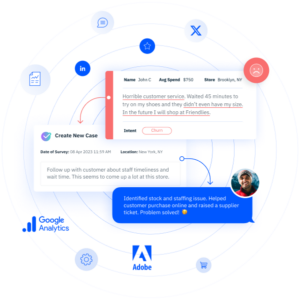Does Who’s Driving the CX Bus Make A Difference?

The success of your CX effort is determined not only by where it lives within your organization, but also by who’s heading up the program and driving its goals, actions, and direction within your company.
This job isn’t easy and not for the faint-of-heart; frankly, CX leaders often end up working against what is natural for an organization. Most businesses are organized into silos: marketing, sales, operations, customer care, HR, IT, finance, etc. These silos all have their own priorities, goals, and KPIs. But customer experience is a ribbon that cuts across these silos, and an effective CX program ensures that hand-offs between silos are clean and that no facet of the customer experience falls into the cracks.
More specifically, marketing drives awareness of your products and solutions, and sets the expectations for how they work and what to expect. Sales sells the vision and aligns the products and services against customer needs. Product development and operations have to deliver against those expectations. IT and the digital team have to provide the tools to keep employees and customers informed and educated, while HR has to get the right people in the right roles to deliver the customer experience.
What to Look for in a CX Bus Driver
A CX leader needs to drive cross-functional alignment, build relationships that elicit cooperation, and break down organizational silos to create coordination across the entire customer journey. They must accomplish this task despite not owning most, if not all, of the departments that ultimately deliver that desired experience.
Again; not for the faint-of-heart.
After decades of leading and guiding CX at multiple companies across multiple industries—and learning our fair share of hard-knock lessons along the way—we’ve landed on eight requirements for successful CX leaders:
- Willingness to be a change agent
- Executive presence and sensibility
- Ability to build cross-functional relationships
- Lead by influence and persuasion
- Strong communication skills
- Analytical and data-driven
- Financial acumen
- Results-oriented problem solver
Clearly, these skills are all heavily intertwined, as a CX leader must have strong communication skills to build relationships and influence executive leaders. They must be data-driven with strong financial instinct to convince leadership to change behaviors or to take new actions (building a strong relationship with the CFO and their team is a smart early move).
Looking At The Road Ahead
The success or failure of a CX program depends on many factors: the strategy and goals defined at the onset, the internal commitment to improvements, the executives, the employees, and the foundational and organizational elements that are in place. CX success also hinges upon appointing a leader who is an effective communicator and can sell a vision, create alignment based
on shared business goals, and curate a shared understanding of customer needs, expectations, and journeys.
CX leaders must have the will and influence to drive demonstrable culture change, improvement, and ROI no matter where they report within the company.
Customer experience is a team sport that requires the participation, alignment, and coordination of the entire organization. But the skills and personality of the CX leader and their ability to sell a vision, as well as use data and storytelling to persuade others to change is critical as well. It’s not easy, but nothing worth doing ever is.
Look for the next article on the other organizational elements that need to be present beyond the CX leader and core team. We’ll come full circle on what all you need to ensure Experience Improvement (XI) for your customers, your employees, and your greater marketplace presence.

